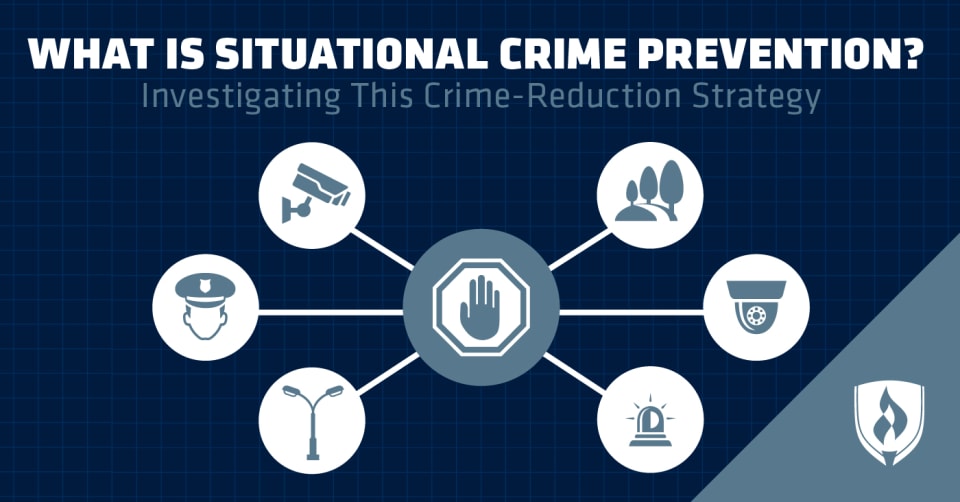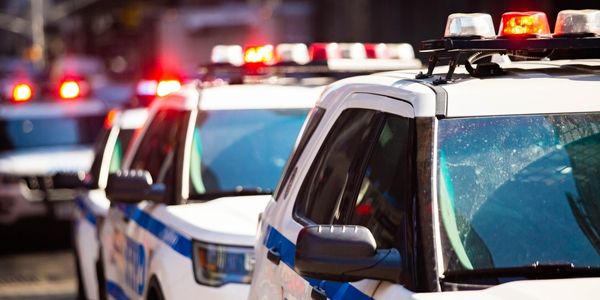What Is Situational Crime Prevention? Investigating This Crime Reduction Strategy
By Ashley Brooks on 01/06/2020

Your favorite television dramas would have you believe that law enforcement is always one step behind the criminal masterminds wreaking havoc on their city. In the real world, however, law enforcement officers use methods like situational crime prevention to protect those in their community before crime occurs.
So what is situational crime prevention? Though you may not have heard the term before, this technique has a history that stretches back more than 40 years, when it was pioneered thanks to research from the British government’s criminology department. Situational crime prevention (SCP) is now used by police departments around the world.
Brush up on your knowledge of situational crime prevention with this look at the foundations of SCP, why it works and examples of real-life crime prevention.
What is situational crime prevention?
Crime prevention has long been on the radar of law enforcement officers, but situational crime prevention brings a different approach. Situational crime prevention is based in the belief that crime can be deterred by making strategic changes to an environment. It does this by focusing on how (rather than why) crime happens—and therefore, how it can be prevented.
“Traditional criminology has focused on the criminal nature of offenders as a means for reducing crime. SCP has instead sought to alter environments which host crime behavior in order to make them less suitable for offending,” according to research by Auzeen Shariati and Rob T. Guerette.1
Law enforcement officers evaluate different types of crimes to determine which situational factors allowed the crime to be carried out. “Then intervention techniques are developed to be used in similar situational factors,” says Emily Andrews, law writer at RecordsFinder. “In theory, these actions and techniques reduce the crime rate during specific types of events.”
SCP is based on four components:2
- Rational choice, which involves understanding the thought process of offenders who choose how to commit a crime
- Specificity, which looks at specific types of crimes to understand the opportunities that allowed the offender to commit a crime
- Opportunity structure, in which analysts gather information from both offenders and victims to create a “map” of the path the offender took to committing a crime
- Techniques for crime prevention that reduce the opportunity for crime
How does situational crime prevention work?
What makes SCP different from other prevention methods is its focus on specific circumstances where actual crimes have occurred or are likely to occur, sometimes referred to as “near crime.” “Situational crime prevention seeks to reduce the harms caused by crime through altering immediate or situational factors in the environments where crime regularly occurs,” write Shariati and Guerette.
Law enforcement officers trained in SCP learn 25 techniques to help deter these types of situational crime. “An important part of SCP focuses on decreasing the benefits crime offers,” Andrews says. “SCP's aim is to reduce the incidence of crime by increasing the risks for offenders and reducing the opportunities for crime,” which is exactly what these techniques are designed to do.
These 25 techniques fall into five categories: increase the effort required to commit a crime, increase the risks of committing a crime, reduce the rewards of crime, reduce provocations to commit an offense and remove excuses for breaking the law.
These techniques can also be thought of as “hard interventions” that make it impossible for an offender to commit a crime, and “soft interventions” that decrease an offender’s motivation for committing a crime.
Examples of situational crime prevention in action
Now that you understand the theory behind SCP, you’re ready to see how it works in the real world. Here are some examples of what SCP looks like in action, based on some of the 25 techniques law enforcement officers are trained to use:
- Removal of target: Parking a luxury car in a garage rather than on the street in an area where vehicle break-ins or auto theft are a problem.
- Increase natural surveillance: When urban planning, including well-lit streets and housing designs that allow neighbors to see one another’s properties.
- Control tools/weapons: Restricting the purchase of guns or other weapons, or not allowing juveniles to purchase spray paint.
- Increase formal surveillance: Install alarms or security cameras in conspicuous places so offenders are aware of any surveillance measures.
- Alert conscience: Roadside signs that flash your speed if you’re driving too fast, or warnings at the beginning of a movie that state “piracy is not a victimless crime.”
Not all of the techniques will work for every type of crime. Law enforcement officers must use critical thinking to choose the SCP techniques that are most likely to prevent a specific type of crime.
What are the benefits of situational crime prevention?
You can imagine that it’s better to prevent a crime than to react after an offense has been committed, but you might not be able to put your finger on why.
Cost-effectiveness is one of the major benefits of SCP. Many SCP techniques are low-cost or even free, such as neighbors who remind each other to lock their car doors at night, or a storefront with signage reminding patrons that shoplifting is a crime and will be prosecuted.
Though it’s notoriously difficult to estimate the costs of crime, it’s reasonable to assume that SCP efforts like these are much more affordable than the costs of dispatching a law enforcement officer and pursuing and prosecuting the offender.
The benefits of SCP don’t stop there. “Research has also found that positive impacts of preventive interventions can spread to other times and locations,” according to Shariati and Guerette. This diffusion of benefits means that SCP essentially has a compounding effect, doing good for multiple communities rather than just one isolated location.
Because of the nature of crime prevention, SCP may have many more benefits than we realize because they simply aren’t measureable. “The SCP approach seeks to deploy opportunity-reducing techniques before large-scale crime problems arise,” write Shariati and Guerette. This approach “has shown much success and arguably offers a more expedient method to reduce crime than traditional crime control mechanisms.”
Keep up with the latest in crime prevention
Now that you have the scoop about situational crime prevention, you might be wondering if there are other law enforcement methods you should know about. After all, TV crime dramas aren’t the best source of accurate information!
Good news! You can easily stay on top of all things law enforcement with these 10 Law Enforcement Blogs to Keep Police Officers Up to Date. Check them out to stay in the loop on crime prevention and more.
1Shariati, Auzeen & Guerette, Rob. Preventing Crime and Violence, Situational Crime Prevention (2017) [accessed December 2019] https://www.researchgate.net/publication/311251189_Situational_Crime_Prevention
2Freilich, Joshua & Newman, Graeme. Oxford Research Encyclopedia of Criminology, Situational Crime Prevention (2017) [accessed December 2019] https://oxfordre.com/criminology/view/10.1093/acrefore/9780190264079.001.0001/acrefore-9780190264079-e-3
Professional Peace Officer Education (PPOE): This program meets standards established by the Minnesota Peace Officer Standards and Training Board (MN POST) for persons who seek employment in Minnesota as a peace officer. Graduates of this program may need to successfully complete additional academic coursework, training, practical/skills, and fitness standards before becoming eligible to sit for the MN Peace Officer Licensing Exam.
This program is not aligned to the standards of any professional licensing body other than the MN POST, and is not intended to satisfy professional licensure requirements of any professional licensing agency in any other state.




